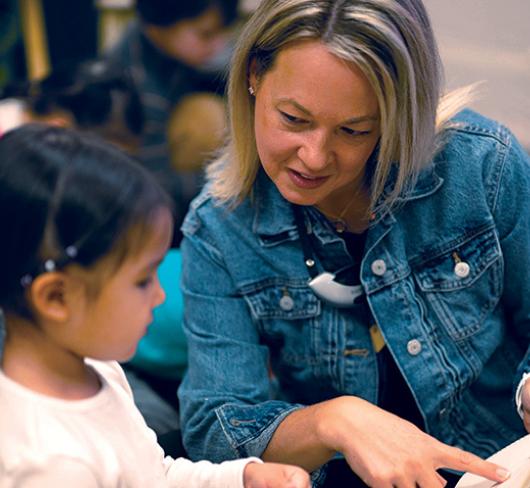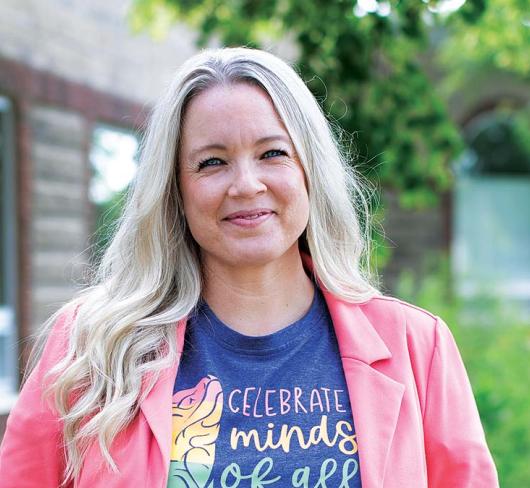Literacy Coaches and Special Education Teachers: A Dynamic Combination
Special education teachers and literacy coaches with the Kawartha Pine Ridge District School Board have found the rewards of a collaborative and collegial working partnership to be worth the effort. At two schools, Roger Neilson and R.F. Downey in Peterborough, the literacy coach and the special education teacher work together to support classroom teachers as they strive to meet the needs of the wide range of learners in their classes.
“Through collaboration we’re giving everyone’s best, including the principal’s and all the teachers’, to our students. The sum of our parts is definitely greater than any one of us individually,” says Nancy McFarland, literacy coach at Roger Neilson.
Special education teacher Jennifer Massie agrees. “My specialty isn’t literacy, it’s special education. It’s really beneficial for us to know we have that expertise to draw from each other and to share with our colleagues and, likewise, the expertise our colleagues have as classroom teachers to share with us and each other.”
Working collaboratively to support the 11 classroom teachers in their kindergarten to grade 6 school has also been a positive experience for literacy coach Pat Wade and special education teacher Karen Dillon, at R.F. Downey, “We’re a team and everyone here is part of it. I don’t think anyone feels alone or that they can’t ask for help,” Dillon says.
Time is a challenge
One of the biggest challenges to overcome is finding the time to collaborate.
Designated release time that allows for formal opportunities to collaborate has been a big part of the success of this model. Special funding that has provided time during the instructional day has given teachers the opportunity to discuss the students and their work, and to plan for improvement. It has also given them an opportunity for professional learning within the school day instead of after hours. Sharing occurs among the staff and grade partners, and teachers help drive their own professional learning opportunities.
The principal plays an important role as leader and partner in this collaborative model, helping to set the tone and demonstrating commitment through regular weekly meetings and by providing release time for teachers to meet. “Everything comes back to the importance of having an administrator who supports us working together as literacy coach and special education teacher, and as a staff working together,” McFarland states.
Teachers have also found that there is a lot of meaningful collaboration happening on the fly – in lunchroom discussions and hallway conversations, through school email and electronic conferences, as well as through more structured opportunities. In both schools, the literacy coach and special education teacher have scheduled weekly meetings with the principal to discuss the school’s SMART (specific, measurable, achievable, realistic, and time-sensitive) goals.
Sharing knowledge, becoming leaders
Collaboration allows teachers to share their expertise. The literacy coach can work with the teacher on interpreting student data and making suggestions for next steps for students, and bring to the conversation a wealth of knowledge and expertise in research-based literacy practices. As well, the literacy coach is available to work with the teacher to plan lessons based on students’ needs, and to model lessons, which helps to build the classroom teacher’s expertise in literacy instruction.
The special education teacher also works with the teacher in the classroom. She brings her knowledge and expertise in differentiating instruction, assessing struggling students to help determine the areas of need, providing suggestions for accommodating or modifying a student’s program, and helping the classroom teacher plan for individual needs and write individual education plans.
While the collaborative model has been successful in many ways, one unexpected side effect has been the opportunity for teachers to become leaders within their school community. Some are choosing to design and deliver professional learning opportunities for their colleagues, with the goal of sharing effective practices. One group of teachers has chosen to expand on their learning and to be involved in ETFO’s Teachers Learning Together project over the 2007–08 school year.
Positive results for students …
The short-term results indicate that this collaborative model has been a success. Developing SMART goals around reading strategies paid off for R. F. Downey School where Pat Wade and Karen Dillon teach. Post-assessment results indicated significant improvement in student achievement after a specific reading strategy was studied, discussed, modelled, and practised. Focusing on inferencing as a strategy resulted in 60 percent of grades 2 and 3 students achieving levels 3 and 4, up from a preassessment level of 0 percent. The number of grade 3 students at levels 3 and 4 increased to 85 percent from 47 percent preassessment. After focusing on the strategy of questioning, the number of grade 6 students performing at levels 3 and 4 more than doubled, going from 33 to 72 percent.
… and for teachers
But the impact of these partnerships is even greater. Helping classroom teachers think about their students who need accommodations or modifications and helping them learn how to meet these individual needs have
been very rewarding for the special education teachers. “When you have more than one adult teaching in the room, students are exposed to a range of instructional styles – for example kinesthetic and visual – so they get a mix of approaches, and you can’t beat that,” says Jennifer Massie. “With SMART goals helping to frame our school’s focus and professional learning, there is a consistency across language, strategies and processes school-wide that the students and teachers can carry forward to the next school year,” adds McFarland.
But it’s not just students who have benefited from the collaboration between special needs and literacy teachers. Other teachers appreciate the help they receive in coplanning, working with class profile information, and supporting individual students’ programs. Sharing ideas and strategies creates a ripple effect throughout the building, with the culture of collaboration resulting in increased dialogue among staff members. Grade partners are sharing what’s working, what isn’t, and problem-solving together.
“Things have changed. Teaching, being part of the school team, it’s a positive thing,” says Pat Wade. “We all speak a common language and use similar research-based teaching strategies.”
Karen Dillon adds: “More than ever before we share our successes and celebrate our student achievement. I love coming to work now, I really do. Not that I didn’t before, but I really love it now.

